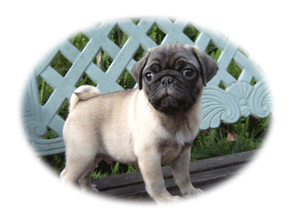
Lucky Charm Kennel
Our Puppies Think They're People!
The History of Pugs and Cavalier King Charles Spaniels
History of our puppies
Pug History

The truth of how the Pug came into existence is shrouded in mystery, but he has been true to his breed down through the ages since before 400 B.C. Authorities agree that he is of Oriental origin with some basic similarities to the Pekingese. China is the earliest known source for the breed, where he was the pet of the Buddhist monasteries in Tibet. The breed next appeared in Japan and then in Europe, where it became the favorite for various royal courts.
The Pug became the official dog of the House of Orange after one of the breed saved the life of William, Prince of Orange, by giving alarm at the approach of the Spaniards at Hermingny in 1572. Later when William II landed at Torbay to be crowned King of England, his cortege included Pugs and they became the fashionable breed for generations.
By 1790 the Pug's popularity has spread to France where Josephine, wife of Napoleon, depended on her Pug "Fortune" to carry secret messaged under his collar to her husband while she was imprisoned at Les Carmes.
In 1860 British soldiers sacked the Imperial Palace in Peking and dogs of the Pug and Pekingese type were brought back to England. This was the first time since the early 16th century that dogs in any great number had been brought out of China. Black Pugs were imported from China and exhibited for the first time in England in 1886. One year earlier, in 1885, the Pug had been accepted for registration with the American Kennel Club.
The Pug is well described by the phrase "multum in parvo" which means "a lot of dog in a small space." He is small but requires no coddling and his roguish face soon wiggles its way into the hearts of men, women and especially children, for whom this dog seems to have a special affinity. His great reason for living is to be near his people and to please them. He is comfortable in a small apartment or country home alike, easily adaptable to all situations.
